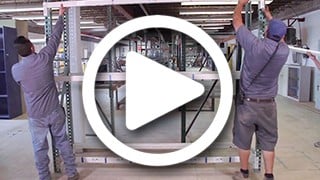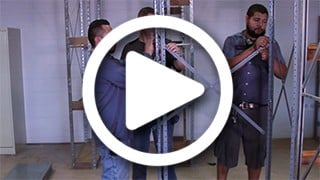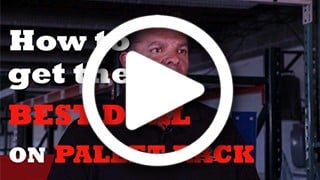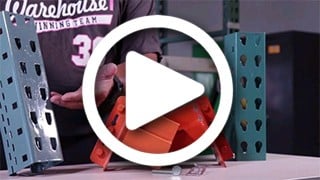How to Hire—and Train—the Best Staff for Your Warehouse

One of the keys to an efficient and effective warehouse is hiring good staff and then training them. There is a lot you need to know about getting a decent and loyal warehouse staff. Here are just a few tips:
- Tips for making a quality job description
- Factor in warehouse culture
- Looking into applicants' references
- Spotting red flags
- Hiring temps
- Establish a good training program
- Go over safety
Tips for making a quality warehouse staff job description
Be detailed and honest
When you write your job description, be sure to make it detailed and be honest about the labor involved in the job. This will save you time and money. You won't be spending as much time with candidates who are not good for the job. If you don't make it honest, they won't know exactly what they're applying for. They're more likely to not be a good fit for the position, or leave soon after being hired.
But, don't make the posting too long. Try to be as concise as possible as to not overwhelm any applicants.
Involve your current staff in the process
One way to ensure a quality warehouse staff job description is to involve your employees themselves. Ask them what they think should be included in the description, and what they wish they had known before being hired.
Note the starting rate
Make sure you have the starting pay in your description and on your posting — and make sure it's competitive. See what the average pay is for that particular job in your area, as well as what your competitors are offering.
Request 2-3 references
Specifically note that only applicants who provide 2-3 references will be considered for this position. References from family members or friends do not count.
Job description examples
Here is an example of a good job posting:

This post works well because they made sure to put the rate of pay in the title, so applicants can see it without going to the description. They line out all of the responsibilities, requirements, and benefits in a clear, detailed and concise way. They are honest about the labor and workload.

Some good job sites to post on are LinkedIn, Indeed, ZipRecruiter, Glassdoor, and more. You can also add job descriptions to Google directly.
Choose the right warehouse culture fit
In your posting, be sure to list off the traits that you would want to see in your warehouse. They need to fit the job properly in terms of personality as well, so they can be lasting additions to your team. Here is a good example of a job listing the right personality traits:

Some traits you'll want to put in your description are:
- Detail-oriented
- Able to lift heavy objects
- Multi-tasker
- Able to work in a fast-paced environment
- Willing to work labor-intensive hours
Be sure to also add in the right traits that fit your warehouse and business needs.
Follow up with applicants' references
This is one of the most important things to do when it comes to hiring warehouse workers. Don't just look to see if the person has references — take the time to call them and have specific questions in mind for those calls.
Anyone can look good on paper, but references are your chance to get insight on their actual job performance. Don't waste it!
Spotting red flags
If you can spot the major red flags in a resume, it will save you hours and hours of time. Be sure to look through each application and try to spot any red flags that may concern you:

- No references: As noted above, references are essential for warehouse job hiring. Even if they're applying for their first warehouse job, they should provide other relevant references.
- Huge employment gaps: If a candidate has a long period of unemployment, this can be a red flag, unless they can give you a valid reason for it.
- Obvious spelling or grammar errors: These types of errors can make any employer assume this candidate does not pay attention to detail, and can give off a bad first impression.
- Lazy mistakes: When a candidate is lazy, they may forget to correct and insert certain things on their application. Did they leave "xxx" in a date or other type of information? Do some of the sentences seem to run-on or cut off? Did they forget to change the company's name they are applying for? If so, these are red flags due to carelessness.
- Confusing formatting: Oftentimes, if someone's formatting is strange, this can be a red flag. Most employers want to see bulleted lists, the important information at the top, and so on. Don't worry too much about how pretty it looks- as long as it makes sense and looks professional.
- Vague job descriptions: You want plenty of information about their previous jobs. The job title isn't enough, as you need to know the duties they had on the job and who their manager was.
- Failing to follow simple directions: This is an obvious one. If your candidate can't follow a simple direction while applying, do you think he/she will while working at your warehouse?

- Applying on their current employer's time: If you get their email with their current employer's email address, while being sent on their work time, you know they are applying while at their current job. If they disrespect their current company, they will probably disrespect you.
- Lacking resume customization or using an obvious template: Using an obvious and non-detailed template makes that candidate seem unprofessional and lazy. Templates are fine, only if they put in all the information and don't have any phrasing that obviously came with the template. This especially goes for cover letters and descriptions.
If there are any of these red flags, you know this may not be a good candidate. But, there are certain red flags the applicant could explain on their cover letter or when responding to interview questions. If they gloss over them, you might want to move on to the next candidate.

Hiring temporary workers
By hiring people from temporary employment agencies, you can get the help you need when you need it. This can be useful for hiring seasonal work in particular. Here are a few tips to hiring and keeping warehouse temps:

- Be sure to stay connected with the temp agencies and hire back your favorites. Having a good relationship with the agencies is important.
- Make a temporary job description on job websites.
- Have the pay be above minimum wage. This way, you get better workers in your warehouse.
- Hire quickly, but be smart and decisive about it.
- Plan to replace about 15% of the temps you get. When you hire for seasonal work, plan to hire more than you need because some of the temps will possibly leave.
- Be sure to train them well. See below for more details on this.
- Be flexible on the hours.
- Be sure to treat them like professionals, and give them the proper respect. You want temps to come back!
Setting warehouse employees up for success
You've hired a quality applicant — great! But how do you ensure he or she will do the job right and become a lasting member of your team? Setting clear expectations from the get-go, with proper training and safety, is essential.
Have a great training program
Having good training will help keep your staff on-time and efficient. Be sure to offer feedback to your staff and refer back to the training manual.
To build a specialized training program for each warehouse job, follow these tips:

- Make a list of the skills and jobs you need to go over for each position.
- Consider having trained forklift drivers give driving lessons. Not everything can be learned by reading or watching.
- Make sure your training is easy to understand and not too drawn out. Most sessions should be around 45 minutes, with plenty of demonstrations and hands-on learning.
- Create a schedule. Make sure it's good for the new employees while still having enough staff to run your warehouse.
- Make sure the new employees learned well from the training. You can run a few tests to make sure no one is struggling. If many are, maybe it's time to go over the training and tweak the process to go into more detail, or maybe slow it down.
Go over safety practices
When you're training your new employees on their jobs and responsibilities, the most important aspect is warehouse safety. In a warehouse, employees will be dealing with dangerous machinery that will require a good deal of training to prevent any injuries, lawsuits, or in the worst cases, death and permanent damage.
Here are the essential safety best practices to keep in mind:

- Falls are the most common accidents. Be sure to train employees to be very aware of their surroundings.
- Keeping your warehouse clean is important for safety. Have a proper layout checklist and keep your space tidy. Train the employees on proper clean up and where everything goes to keep the warehouse organized and efficient.
- Slipping is another common injury. Be sure to train people to clean up any spills and loose materials such as sawdust. Be sure employees get non-slip shoes.
- Make sure you have good training on your machinery. We can't stress this enough. Go over it multiple times throughout the year if needed.
- Fire safety is important. Have your fire exits marked well, and make sure every employee follows proper fire procedures and rules.

- Make sure the employees are trained on stacking objects and boxes correctly. You don't want anything falling on someone, or breaking on the floor, causing damage and hazards.
- Train your employees on proper lifting techniques to avoid major back injuries.
- Have your employees trained about hazardous chemicals. Make sure they wear masks when needed and follow the proper guidelines to avoid leaks and fires.
Conclusion
Having a good warehouse staff begins with a good hiring process and ends with a great training program. Follow these tips to help make sure you'll have an efficient warehouse with a great staff.
To outfit your warehouse staff with the warehouse equipment they need, contact us online or call us at (816) 483-6999.



